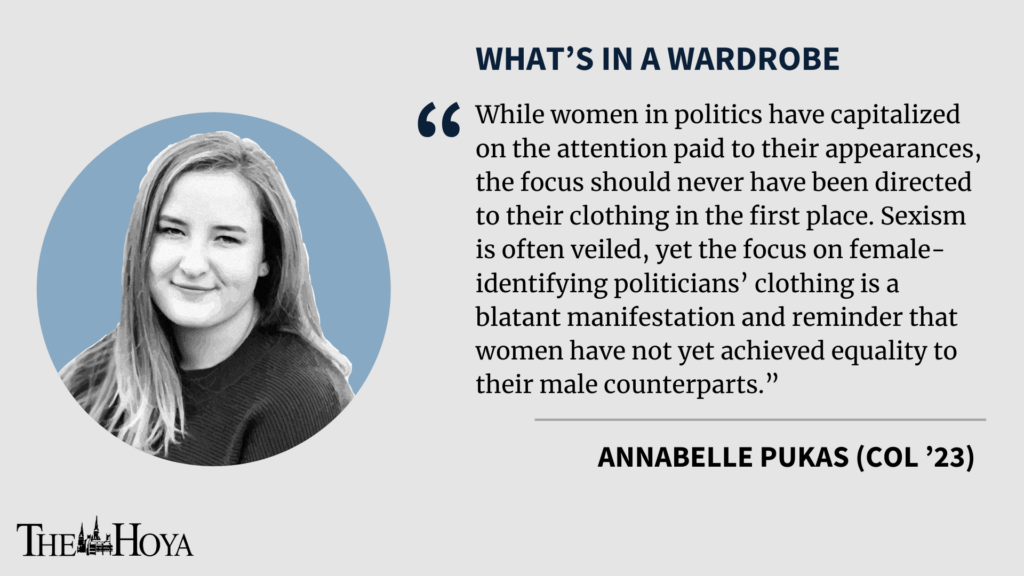“The reality of being a regular person going to Congress is that it’s really expensive to get the business clothes I need for the Hill. So I’m going thrift shopping tomorrow,” Cori Bush (D-Mo.), a newly elected congresswoman, tweeted Nov. 10.
While Bush’s tweet discusses the inaccessibility of professional clothes, it also alludes to a larger issue: the disproportional judgement that female-identifying politicians face for their clothing choices. Since their femininity tends to be viewed as superficiality, female-identifying politicians often face great pressure to carefully monitor their appearances while they are in the public eye.
Critiques of female-identifying politicians’ clothing that objectify them and discredit their position first became mainstream when Rep. Jeannette Rankin (R-Mont.) was elected in 1916 as the nation’s first congresswoman. Following her election, The Washington Post ran a piece titled “Congresswoman Rankin Real Girl; Likes Nice Gowns and Tidy Hair,” a prominent example of how the media focused on her appearance.
Instead of discussing Rankin’s political agenda, the article focused on how she was a “thoroughly feminine” woman with a “charming coiffed swirl of chestnut hair” and “small, high and distinctively French heels.”
During her time in Washington, D.C., Rankin wore dark-colored dresses in conservative cuts to conform her style to more masculine expectations of dress and thereby minimize her femininity, a likely manifestation of the judgement she faced.
It wasn’t until 1993 that women challenged the standards of female-identifying politicians’ dress. Sen. Carol Moseley-Braun (D-Ill.), the first Black female senator, shocked her fellow representatives when she arrived on her first day wearing a pantsuit.
With her suit, Moseley-Braun had defied the implicit “no pants allowed” rule that was commonplace among female-identifying politicians. At first, her mostly male peers seemed apprehensive, but Moseley-Braun’s challenge of the system led Martha Pope, the Senate sergeant-at-arms — the highest ranking federal law enforcement officer in the Senate — to amend the written policy manual to explicitly include pantsuits in the advised women’s dress code.
Even though Mosely-Braun introduced the pantsuit to the Senate floor over 20 years ago, female-identifying politicians still face harsh judgment from their male counterparts and the media. Recently, conservative news reporter Eddie Scarry tweeted a photo of Rep. Alexandria Ocasio-Cortez (D-N.Y.) with the caption: “that jacket and coat don’t look like a girl who struggles.”
Project Runway’s Tim Gunn criticized one of Hillary Rodham Clinton’s pantsuits by saying “Why must she dress that way? I think she’s confused about her gender,” and total strangers told British politician Jo Swinson she should wear “lower cut tops” to help boost her party’s chances of winning an upcoming election.
While women have grown to understand additional scrutiny to be a fact of modern times, female-identifying politicians have also used the increased emphasis on their clothing to their advantage.
The suffragettes adopted white clothing in the early 20th century to create a visual statement about their intent to bring civility and purity into politics, and the color continues to be worn by female-identifying politicians to make political statements. During President Donald Trump’s 2019 State of the Union Address, Democratic congresswomen banded together and wore white to pay homage to women’s history, and Vice President-elect Kamala Harris also wore white during her November 2020 victory speech.
Rep. Lois Frankel (D-Fla.) told CNN there is a striking image created by such intentional choices, one that is “a respectful message of solidarity with women across the country, and a declaration that we will not go back on our hard-earned rights.”
While women in politics have capitalized on the attention paid to their appearances, the focus should never have been directed to their clothing in the first place. Sexism is often veiled, yet the focus on female-identifying politicians’ clothing is a blatant manifestation and reminder that women have not yet achieved equality to their male counterparts.
To shift away from these gender disparities, modern voters must address how gender roles are reinforced through societal structures and how that impacts women’s ability to be elected and succeed in politics.
After all, clothing should never be the sole determinant of respectability or authority, and a person’s worth is certainly not limited to what is in their wardrobe.
Annabelle Pukas is a sophomore in the College. What’s in a Wardrobe appears online every other Thursday.









